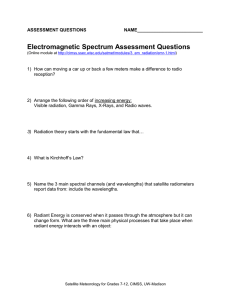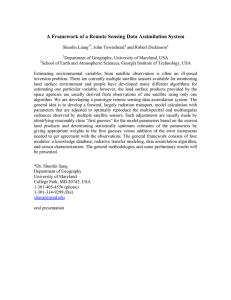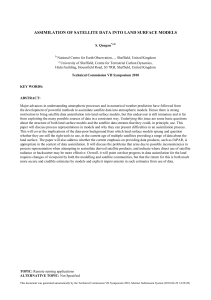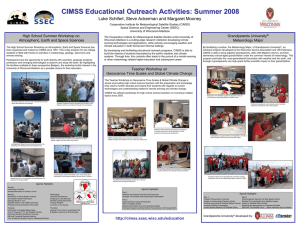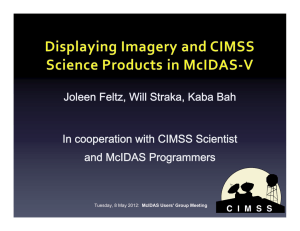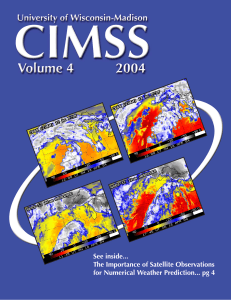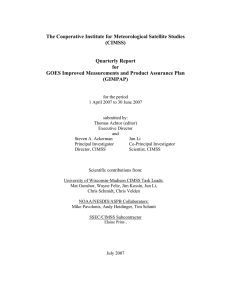Satellite Meteorology – the last 25 years –
advertisement
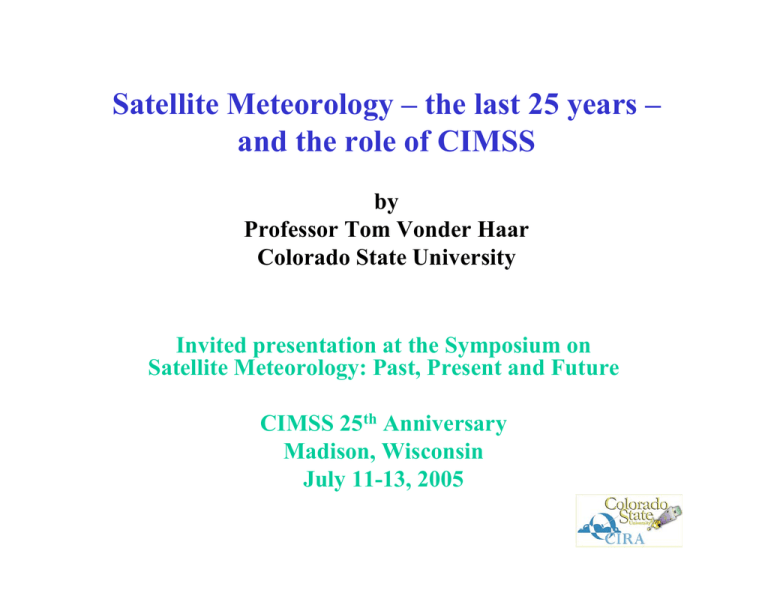
Satellite Meteorology – the last 25 years – and the role of CIMSS by Professor Tom Vonder Haar Colorado State University Invited presentation at the Symposium on Satellite Meteorology: Past, Present and Future CIMSS 25th Anniversary Madison, Wisconsin July 11-13, 2005 The US SatMet Program 1980-2005 1980 Exploitation of Robust POES and GOES Systems 1985 Era of Microwave Imaging and Sounding Begins Return of the “Small Sats” An explosion of Data Information and Visualization Systems 1990 Experimental/Operational SatMet products and the Internet Era 1995 2000 Transition from “Weather” to Environmental Satellite Systems / NPOESS Beginning of Satellite Data Assimilation More Active Sensors – Radar, Lidar, Scatterometers Advances from EOS 2005 Prototype System of Systems and the “A-Train” GEOSS and the ESAS Decadal Study Exploitation of Robust POES and GOES Systems Advanced TIROS-N •TIROS-N/NOAA series developed from Nimbus and ESSA •GOES 4-7 from ATS and SMS GOES-7 •POES now measures clouds, SST, T, q, Ozone, ERB and more CIMSS leads in product development for the GOES program Era of Microwave Imaging and Sounding SSMI(3) ATOVS AMSU TOVS SSM/T2 TMI •Multiple satellite products are blended to create the NVAP dataset. •January 1, 2000 Total Precipitable Water (TPW) shown here. 0 10 20 (Vonder Haar et al. 2005) 30 40 50 60 70mm CIMSS and other groups begin to combine microwave, visible and infrared data Return of the “Small Sats”-1984 •This NASA/CSU/BALL/TRW Mission joins SAGE, TRMM, QuikScat and others to add to US Environmental Satellite research and operations CIMSS and many other scientists join science teams for the small satellite missions An Explosion of Data Information and Visualization Systems CIRA, CSU real time GOES image transmitted to NWS, DEN, July, 1980 •McIDAS, ADVISAR, RAMSDIS, AWIPS et al. bring SatMet products to many users CIMSS, SSEC develops real time products for Miami, Kansas City and more More Active Sensors: RADAR, LIDAR, Scatterometer TRMM RADAR CIMSS, CIRA and others develop cross-sensor forecast products Experimental/Operational SatMet Products and the Internet Era •Many research-to-operations groups place new SatMet products on the web – to the forecasters delight! Black: 100-250 mb Cyan: 251-350 mb Yellow 351-500 mb GOES-12 water vapor winds from CIMSS July 7, 14:15 UTC GOES Sounder Total Precipitable Water July 7, 14:00 UTC from CIMSS Era of Satellite Data Assimilation • From 1995 onward global assimilation of cloud-free satellite radiances shows positive impact • Today we focus on global and regional DA in cloudy cases (4D assimilation of GOES imager IR multi-layered non-convective case) BEFORE ASSIMILATION Model 3D cloud AFTER ASSIMILATION 10e-04 g/kg Optically thin cirrus 10e-03 g/kg * 10e-02 g/kg ARM central site 2D + Tb prior (Vukicevic et al. 2004) = Observations posterior Sequence every 15 min End time shown Prototype System of Systems and the “A-Train” By mid 2005, we expect to have a wide range of different sensors, active and passive, optical, infrared and microwave, hyper-spectral to coarse band, all approximately viewing Earth at the same time. We are left to pose a strategy that optimally combines these measurements, converting them to meaningful information with verified uncertainties. (G. Stephens, 2005) CSU Graduate Class with early CloudSat in the background CIMSS, CIRA, CICS and others have assisted the education of many in our field Are we training and entraining enough young scientists and engineers? More background on the last 25 years For 1960-1995 Kidder, Stan and Tom Vonder Haar, 1995: Satellite Meteorology: An Introduction, Academic Press, 466pp. (First Ed.) For 1995-2005 (2nd Ed. of above, 20xx) Back up slides Comparison of the Total Column Water Vapor, Sea Surface Temperature, and Lower Tropospheric Temperature Anomalies - Global Means Three Independent Satellite Measurements – Highly Coupled 1.50 0.8 Mt. Pinatubo Eruption March 1991 1.20 0.90 Major El Nino begins May 1997 0.7 0.6 0.5 0.4 0.60 0.3 0.2 0.1 0.00 0.0 -0.1 -0.30 -0.2 -0.3 -0.60 Total Column Water Vapor Anomalies - NVAP -0.90 -0.5 Lower Tropospheric Temperature Anomalies - MSU -1.20 Sea Surface Temperature Anomalies - Reynolds -1.50 1988 -0.4 -0.6 -0.7 -0.8 1989 1990 1991 1992 1993 1994 1995 1996 1997 1998 1999 oC (mm) 0.30
